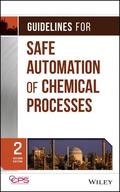Guidelines for Safe Automation of Chemical Processes

2. Auflage Dezember 2016
648 Seiten, Hardcover
Wiley & Sons Ltd
This book provides designers and operators of chemical process facilities with a general philosophy and approach to safe automation, including independent layers of safety. An expanded edition, this book includes a revision of original concepts as well as chapters that address new topics such as use of wireless automation and Safety Instrumented Systems. This book also provides an extensive bibliography to related publications and topic-specific information.
List of Tables Xvii
Abbreviations Xix
Glossary Xxiii
1 Process Safety and Safe Automation 1
1.1 Objective 7
1.2 Scope 9
1.3 Limitations 9
1.4 Target Audience 11
1.5 Incidents That Define Safe Automation 13
1.6 Overview of the Contents 18
1.7 Key Differences 21
2 The Role of Automation in Process Safety 23
2.1 Process Operations 23
2.2 Plant Automation 33
2.3 A Framework for Process Safety 42
2.4 Risk-Based Design 54
2.5 Risk Management of Existing Facility 78
3 Automation Specification 83
3.1 Process Automation Lifecycle 83
3.2 Functional Specification 91
3.3 Designing For Operating Objectives 92
3.4 Inherently Safer Practices 104
3.5 Designing for Core Attributes 107
3.6 Control and Safety System Integration 133
4 Design And Implementation Of Process Control Systems 153
4.1 Input and Output Field Signal Types 161
4.2 Basic Application Program Functions 162
4.3 Process Control Objectives 165
4.4 Process Controller Technology Selection 172
4.5 Detailed Application Program Design 194
5 Design and Implementation of Safety Controls, Alarms, and Interlocks (SCAI) 211
5.1 SCAI Classification 215
5.2 Design Considerations 220
5.3 SCAI Technology Selection 244
6 Administrative Controls and Monitoring 265
6.1 Introduction 265
6.2 Automation Organization Management 266
6.3 Process Safety Information 269
6.4 Operating Procedures 273
6.5 Maintenance Planning 291
6.6 Human and Systematic Failure Management 303
6.7 Management of Change 316
6.8 Auditing, Monitoring and Metrics 321
Appendix A. Control System Considerations 329
Appendix B. Power, Grounding, and Shielding 371
Appendix C. Communications 391
C.1 Communication Classifications 391
C.2 Common Communication Network Topologies 395
C.3 Communication between Devices 397
C.4 Wireless Communication 400
C.5 Common Communication Configurations 403
C.6 Common Data Communication Issues 407
C.7 Process Control and Safety System Communications 412
C.8 SCAI Communications 419
Appendix D. Alarm Management 423
D.1 Alarms 423
D.2 Standards and Resources 423
D.3 Alarm Management 423
D.4 Managing the Safety Aspects Of Alarms 436
D.5 Alarm System Performance Benchmarking 437
D.6 Alarm Management Software 438
Appendix E. Field Device Considerations 441
E.1 General Signal Safety 441
E.2 Field Device Selection 458
E.3 Flow Measurement 465
E.4 Pressure Measurement 475
E.5 Level Measurement 476
E.6 Temperature Measurement 487
E.7 On-Stream Process Analysis 489
E.8 Automated Valves 493
E.9 Electric Motors 504
E.10 Steam Turbine Variable Speed Drives 505
Appendix F. Sis Equipment Selection 511
F.1 Selection Basis 511
F.2 Additional Considerations 518
Appendix G. Human Machine Interface Design 529
G.1 General 529
G.2 Operator Interface Standards and Resources 531
G.3 Instrument Panels 533
G.4 Configurable Operator Workstations 534
G.5 Process Alarms 538
G.6 Sis Impact on HMI 545
G.7 Control-Center Environment 545
G.8 Video 546
G.9 Operator Interfaces Of Future 546
G.10 HMI Considerations Checklist 547
Appendix H. Application Programming 551
H.1 Software Types 551
H.2 Application Program Development 552
H.3 Application Programming Languages 554
H.4 Application Program Developmental Models 556
H.5 Process Control Application Program 557
H.6 SCAI Application Program 563
Appendix I. Instrument Reliability Program 565
I.1 Introduction 565
I.2 Tracking Failure 566
I.3 Data Taxonomy 568
I.4 Data Collection Efforts 569
I.5 Failure Investigation 571
I.6 Calculation of Failure Rate 572
I.7 Verification 576
Appendix J. Acceptance Testing Guidelines 581
J.1 Acceptance Testing 581
J.2 Standards 581
J.3 Factory Acceptance Test 582
J.4 Site Acceptance Test (SAT) 589
Index 597


